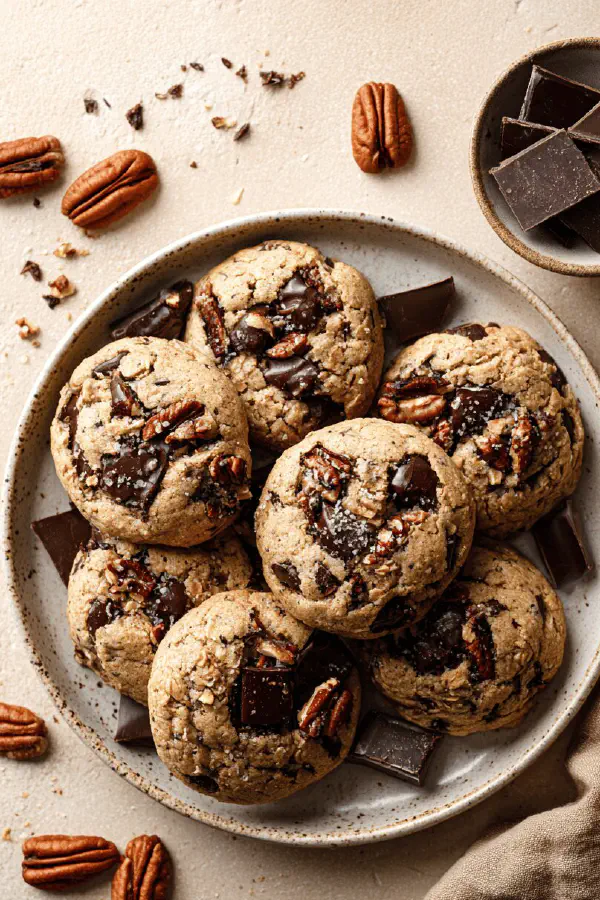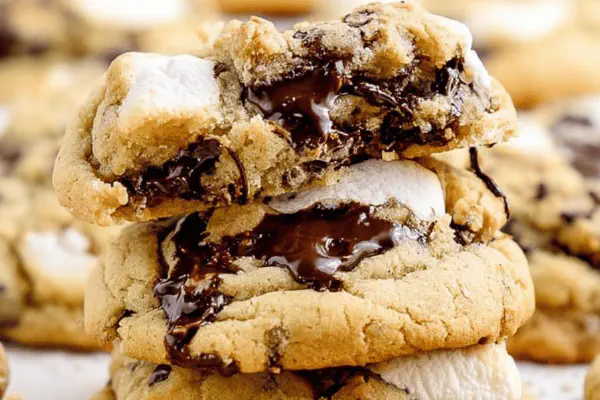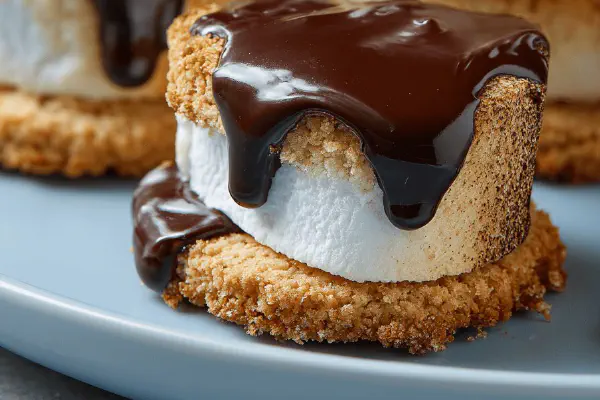Featured Recipe
Soft Chocolate Chip Cookies

By Kate
"
Soft cookies made with a mix of all-purpose and oat flour, brown sugar, browned butter, and egg yolks. Includes chopped dark chocolate and toasted pecans for texture and flavor. Uses baking powder instead of baking soda for a different rise. Bakes at lower temperature for a tender crumb, edges just turning golden. Simple steps focused on texture cues and flavor build.
"
Prep:
20 min
Cook:
15 min
Total:
35 min
Serves:
14 cookies
baking
cookies
chocolate
desserts
Introduction
Hands in flour. Butter just browned, smell nuts, fragrant. Sugar gritty? Stir till glossy, no grain left. Egg yolks only. No whites, no fluff. Flour mixture changes here. Oats to bulk, baking powder to puff instead of soda. Pecans for crunch, bittersweet chocolate chunking. Mix gentle, fold not stir. Clumps ruin texture. Chill dough or cookies spread thin, lose body. Low heat baking, slow and steady gets tender cookie, golden edges, soft center. Smell deepens, crackle near edges signals doneness. Don’t trust timer alone watch color and feel. Cookies can turn dry fast, better just shy than overbaked.
Ingredients
About the ingredients
Brown butter matters, cooks off moisture, adds nuttiness. Don’t burn, timing key. Oat flour optional—adds chew, whole texture. Use pecans for contrast; walnuts or hazelnuts work too. Can replace browned butter with regular softened butter but adjust leavening slightly—baking soda needed to compensate. Brown sugar keeps moist, white sugar makes crispier cookie. Egg yolks lend richness and chew without raising dough too much. Vanilla adds complexity, pure extract preferred. Chocolate chunks bitterer than chips, chunk size affects melt. Chilling dough controls spread, improves flavor melding.
Method
===
- 1 Start with tempered browned butter. Melt butter in saucepan over medium heat. Swirl, watch for nutty aroma and brown specks. Immediately remove from heat and cool slightly. Avoid burnt taste by pulling off heat right as solids brown.
- 2 In a large bowl, whisk together all-purpose flour, oat flour, baking powder, and salt until evenly combined. Sifting optional for even mixing but whisk well to prevent lumps. Swap oat flour with finely ground almond flour for nuttier flavor but watch texture changes.
- 3 In a separate bowl, combine cooled browned butter and brown sugar. Stir vigorously with wooden spoon or rubber spatula until smooth, slightly glossy, and fully mixed. Brown sugar must dissolve into butter for moist crumb. Grainy texture means under-mixing.
- 4 Add egg yolks one at a time, stirring thoroughly after each addition. Incorporate vanilla extract. No egg whites here — yolks add richness and tenderness, keep dough dense and soft. Over-mixing can develop gluten; mix just until combined.
- 5 Fold the dry ingredients into wet mixture in two additions. Use spatula or wooden spoon, fold gently but thoroughly to avoid pockets of flour. Stop once no dry flour visible. Fold in chopped chocolate and toasted pecans evenly dispersed. Pecans add crunch and savory contrast, optional if allergic.
- 6 Cover bowl with plastic wrap or kitchen towel. Chill dough minimum 30 minutes. Chilling solidifies fats and prevents cookies from spreading too thin during baking. Dough feels cooler and stiffer, easier to portion.
- 7 Preheat oven to 150 °C (300 °F). Position oven rack in center third. Line two baking sheets with parchment paper or silicone mats. Lower temp than usual to encourage even baking and prevent over-browning edges.
- 8 Using two spoons or medium cookie scoop, form 40 ml (approx 2 2/3 tbsp) mounds spaced 5 cm (2 inches) apart on baking sheets. Big enough for soft centre but will flatten slightly while baking. Slightly chew admix dough with fingers to smooth tops, promotes even rise.
- 9 Bake 14-16 minutes depending on oven’s hot spots. Edges should turn pale golden and firm. Center remains soft, puffy but not wet or raw. Muffin-top effect desirable. Listen for light crackling sound at edges, scent will deepen. Avoid baking beyond first golden notes or cookies dry out.
- 10 Remove sheets from oven. Let cool 4-5 minutes on pan — cookies finish cooking from residual heat, centers set and don’t fall apart when moved. Transfer gently to wire rack to cool completely. Store airtight at room temp up to 5 days or freeze.
- Notes: If no browned butter, regular softened butter is okay, cut baking powder to 2 ml (1/2 tsp) and add 1/4 tsp baking soda for lift. Swap pecans with walnuts or leave out. For dairy-free, coconut oil solid at room temp can replace butter, flavor shifts to tropical notes. Watch dough hydration if using different flours; some absorb more. Brown sugar preference leans moist but white sugar can tweak texture—expect crisper bite.
- Avoid overworking dough. Overmixing flour activates gluten, yields tough cookies. Don’t skip resting/chilling step. Batch size yielded around 14 generous cookies, reduce size for more but thinner and crisper cookies.
- Cookies will firm up when cooled but remain chewy inside. Reheat briefly for melty chocolate moments.
===
Technique Tips
Brown butter first, cool before mixing to avoid cooking eggs. Fold dry into wet gently to avoid gluten toughening. Watch dough hydration; too dry or wet means texture issues. Dough stiff enough for scooping but yields soft cookie. Chill dough minimum 30 min, better up to 2 hrs or overnight for flavor depth. Baking temp lowered to 150 °C slows caramelization, getting tender crumb not crusty edges. Timing 14-16 min depends on oven and cookie size. Look for pale golden edges, soft center that holds shape when nudged. Cool on pan briefly so cookies finish baking from residual heat. Transfer carefully to avoid breaking soft centers. Store airtight, refresh in warm oven if needed.
Chef's Notes
- 💡 Brown butter first; nutty aroma signals readiness. Watch carefully, pull off heat as solids brown. More flavor, less burnt taste. Texture matters.
- 💡 Oat flour optional; swap with almond flour. Adjust if needed. Can affect dough hydration. Mix dry ingredients well, avoid any lumps...
- 💡 Chilling step critical; under-chill? Spread too much in oven. Dough should be stiff. Cooler means better texture, holds shape well.
- 💡 Space dough mounds properly on sheets. Give them room to spread. Slight flattening is good; helps bake evenly. Tweaking the size affects baking time.
- 💡 Watch your baking time carefully. Oven spots differ; rotate sheets halfway for even baking. Strong smells and crackling? That’s your cue to check progress.
Kitchen Wisdom
How to get that chewy texture?
Use just egg yolks—helps richness without fluff. Over-mixing activates gluten; keep it gentle.
Can I use regular butter instead?
Sure, but adjust leavening. Cut baking powder. Add a bit of baking soda for lift.
What’s the best way to store them?
Airtight container at room temp up to 5 days. Freeze for longer storage, thaw before eating.
Why are my cookies flat?
Likely dough too warm; proper chilling prevents spreading. Use parchment paper to maintain shape.



